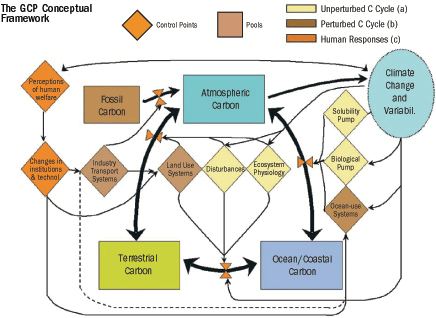Figure 5

Figure 5. The global carbon cycle from three perspectives over time. (a) During glacial–interglacial periods and before significant human activities, the global carbon cycle was a linked system encompassing stocks in the land, oceans and atmosphere only. The system was (and still is) controlled or driven through climate variability as well as its own internal dynamics. For example, the ocean carbon system was tightly coupled to air–sea gas exchange as well as physical and biological ‘pumps’ that transport carbon. Interactions of the land surface and atmosphere were driven by land and ecosystem physiology as well as disturbance. (b) Starting about 200 years ago, industrialisation and accelerating land-use change complicated the global carbon cycle by adding a new stock — fossil carbon. However, humans did not initially perceive that their welfare might be endangered. Regardless of how society responds to increased fossil fuel inputs to the atmosphere, or the consequences of intensification of current land-use practices, the global carbon cycle has been seriously impacted. (c) Over recent decades, humans have begun to realise that changes in climate variability and the Earth system may significantly affect their welfare as well as the functionality of the global carbon cycle. The development and implementation of institutions and regimes to manage the global carbon cycle coherently provides a new set of feedbacks in the contemporary era.
